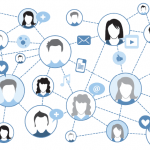
Syda Productions/shutterstock.com
Forty-five years ago, a computer engineer in Boston sent an electronic message between two computers some 10 feet apart. It took another 10 years or so before the electronic mail message was dubbed email—a term now, perhaps, more ubiquitous than any other in the lexicon of modern communications.
Despite the seemingly definitive place email communication holds for rheumatologists—for messages to each other, missives to hospital administrators, instructions to patients and myriad other uses—some people wonder if email is outmoded. In a world of text messaging, Facebook, Twitter, Skype, Vine, Periscope and Google Talk—not to mention dozens of lesser known services and a seemingly endless string of startups aiming to be the proverbial next big thing—is email old-fashioned or ineffective?
In a word, no.
“Email is pretty much here to stay,” says lupus expert Swamy Venuturupalli, MD, FACR, who leads the ACR/ARHP Annual Meeting subcommittee that focuses on technology innovations and is clinical chief of rheumatology at Cedars Sinai Medical Center in Los Angeles. “Email is the dominant form of communication at the current time and if email continues to evolve, it will continue to remain relevant and useful to accomplish quick and confidential communication in the medical setting.”
But that doesn’t mean email is the only communications method in a rheumatologist’s toolbox or the best one for every situation. Physicians and communications experts interviewed by The Rheumatologist agree that email has a function and isn’t going anywhere anytime soon. However, that function is dependent on trust, urgency, formality and relationships.
“I’m exploring other ways of communicating with teams and colleagues,” says Jonathan Hausmann, MD, a fellow in pediatric and adult rheumatology at Boston Children’s Hospital/Beth Israel Deaconess Medical Center. “For instance, I have projects where I collaborate with people at other institutions. We need efficient ways of communicating and sharing documents with each other. Using Slack, we created different channels to address various parts of our projects, including IRB documents, study survey, software improvements, etc.”
Professionalism
Communications consultant A.J. Moore, an associate professor of communication at Rider University in Lawrenceville, N.J., put it even more bluntly when assuring that email isn’t going anywhere.
“Research shows, and I know I do it myself, the first thing I do in the morning when I pick up my phone is check my email,” he says. “People often check their email before they check the weather, before they check social media. Sure, there are other places to go, there are other ways of communicating. But I still think that email is the center point. It’s the starting line for your communication.”
Physicians & communications experts interviewed by The Rheumatologist agree that email has a function & isn’t going anywhere anytime soon. However, that function is dependent on trust, urgency, formality & relationships.
The urgency that comes with a text message or a direct message on Facebook or Twitter is the flip side of the formality that comes with an email, says Mr. Moore.
“Email has more of a professional connotation to it than a Facebook message,” Mr. Moore says. “Even if I work with somebody, even if I’m Facebook friends with somebody and that person is one door away from me, if it is a work conversation I am going to send them an email.”
Formality is the delineation between social media and what Mr. Moore half-jokingly calls “professional media.” And while in some ways, technology gaps can often be a generational difference, Mr. Moore doesn’t see email usage through that prism—certainly not when he’s interacting with the young adults in his classes. “Students know … they could find me on social media,” he says. “There’s nothing preventing them, but still they reach out to me via email, and I communicate with them via email.”
That said, a generation gap does exist that can cause older physicians not to embrace newer technologies that could be effective alternatives to email, says Howard Landa, chief medical information officer of the Alameda Health System in Oakland and vice chairman of the Board of Advisors for the Association of Medical Directors of Information Systems in Lake Almanor, Calif. Many communication tools—Shortmail, Fridge, Apple Mail—were discontinued, wrapped into larger technologies or never became mainstream enough to be worthwhile. So the idea that some technologies won’t catch on discourages some from using anything but email.
“The younger we are, the easier the changes are, and the more receptive we are to change,” Mr. Landa says. “We have seen a lot of flash-in-the-pan technology, snake oil, new ideas that go crazy for [a while]. They get to the top in the hype cycle; they drop to the bottom of the pit in the depression, and then they never move.
“With the older physicians, I think there is a reluctance to try something just because it’s new; whereas, with the younger docs there is a new technology every week that I want to try because I am willing to go through 20 of them before I find one that works. They have more energy and are more open to it.”
Security & Privacy
But it’s not just the age divide between newer and veteran rheumatologists, says Dr. Venuturupalli.
“No, I don’t think that’s all it is,” he says. “There are some real concerns about using these technologies too much and not thinking through the implications of the security and privacy issues around them.”
The safety of email is a major reason that many continually question its fate. In a broad sense, that is the natural question of any new technology, says Ben Compaine, MBA, PhD, director of the Fellows Program at the Columbia University Institute for Tele-Information and a lecturer in the D’Amore-McKim School of Business at Northeastern University in Boston.
“There are always people who will find something to fear,” he says. “Like when ATMs came along, there was stuff being written about safety concerns: ‘People will go to an ATM and someone just holds them up and gets their money.’ It’s happened, but given the hundreds of millions of transactions that go on, you don’t throw out the baby with the bathwater.”
Mr. Landa believes that part of the problem with the efficacy of email is that it’s become so fast and so easy that people don’t take their time thinking about the impact of each email.
Another potential pitfall of the efficacy of email is the “lost in translation” phenomenon, Mr. Landa says.
“How many times have you written an email and someone misinterpreted sarcasm or a joke or a particular word or a phrase and got upset because of what they thought you were saying?” he says. “The synchronous and rapid-fire style of the forms of communication elevates the risk by an order of magnitude. I think that’s the reason we have developed all the emoticons and all the visual references that are out there, to make sure that people don’t misinterpret what we’re saying.”
The urgency that comes with a text message or a direct message on Facebook or Twitter is the flip side of the formality that comes with an email.
Privacy is a concern Dr. Hausmann has thought about more than once. He likes his patients to have access to their medical notes, but in a way that is secure. So instead of emailing him directly, he recommends his patients use his hospital’s patient portal, where they can read their clinic notes and email him in a method that is secure and HIPPA compliant. Then the communication can be easily added to the patient’s medical chart.
“Our patient portal has certain security standards where all the messages are encrypted and stored in our secure severs, so that works really well,” he says. “It’s a great thing for patients to be able to read my notes, because I think we often overwhelm them during the medical encounter about all the things they need to do. Having a patient portal is a wonderful resource where patients can review their notes directly and easily send me a message if they have any questions.”
Progress
Daniel Solomon, MD, MPH, associate physician at Brigham and Women’s Hospital and a professor of medicine at Harvard Medical School, both in Boston, says that for research-focused rheumatologists, email remains the most effective tool for most day-to-day communication.
“It’s a huge part of my life,” he says. “It allows people to have asynchronous conversations. Allowing progress to occur without scheduling dedicated time is tremendously important … the most important conversations are [still] held face to face, but so much happens between those major decisions. It’s how to make all the small decisions. It’s hundreds of emails later every day [that] allows projects to move forward.”
Once the research is done, however, Dr. Solomon uses Twitter to promote it. There he sees value in the new technologies that can put research in front of people other than the dedicated readers of Arthritis Care & Research and Arthritis & Rheumatology.
“As a researcher, we’re constantly trying to get our research findings out to a broader community and trying to make sure academic journals are [not] the only way to get the word out,” he adds. “The use of social media in the research space has grown tremendously over the past five or 10 years … allowing us to broaden the reach of science.”
Bells & Whistles
So if rheumatologists and communications experts believe email retains a place in the way information is conveyed, why is the question of its impending death a continuing parlor game for some?
“Because there’s always something new,” Mr. Moore says. “Because Messenger on Facebook looks a little bit flashier than email. Because now we have Periscope. Now we have Twitter. Now we have different types of platforms that message within each other. They all look flashier.”
In essence, each is simply a somewhat more modernized version. More bells and whistles, Mr. Moore says. He likes to compare it to the U.S. Postal Service. As technology progressed and communication became more real time in ways well beyond telephone conversations, many pundits forecast the end of what is derisively called snail mail, itself an admission of the speed and efficacy of electronic mail.
“You could make the analogy between the death of
and the death of the U.S. mail,” Mr. Moore says. “Ten years ago, people were writing about the death of the U.S. mail. And it certainly changed, and yes, there are fewer letters and less traffic and fewer parcels that the post office sends. But it’s still there. It’s not going away; it’s just adapting in a certain way. If you want to pinpoint a time that there is ‘the death of email,’ I think the death of the U.S. mail comes before it.”
Richard Quinn is a freelance writer in New Jersey.
A Who’s Who of Communication Tools
Alternatives to email have proliferated in recent years, yet technology research firm The Radicati Group reported last year that there are 2.6 billion email users worldwide. Said another way, one in every three human beings uses email. Some use other services, such as:
- Facebook Messenger: A free instant-messaging service available on both desktops and mobile devices, it offers real-time connectivity. The service had 800 million users as of January 2016, according to statista.com.
- Twitter: The online social networking site offers private messaging. People must be connected to each other to use the service. The company reports 320 million active monthly users.
- Skype: An application that allows video and voice calls. Set up as a so-called “freemium” model, meaning basic services are free but premium services can cost monthly. Statista.com reported 300 million active monthly users last year.
- Google Talk: At 10 years old, the grandfather of instant messaging services allows for both real-time texting and video calls. Part of Google+, which statista.com last year said had 300 million active monthly users.
- Vine: A video-sharing service where users can transmit six-second clips, Vine is owned by Twitter. In May 2015, it reported 100 million monthly views.
- Periscope: Live-video streaming service available as a mobile application, the service was launched in March 2015. It is also owned by Twitter. It had a reported 10 million accounts as of August 2015.
- Evernote: This organizational app allows for shared files and has a talk function. Statista reported 150 million users as of July 2015, up from 100 million a year earlier.
- Slack: Another organizational app that aggregates information from other apps giving a user access to communications from various tools in one spot. It recently launched additional phone and video services. The company has reported 2.3 million active daily users, 675,000 of whom pay for the service.
—RQ

